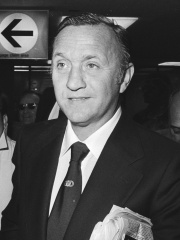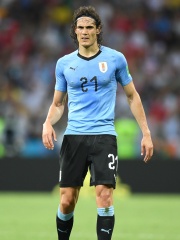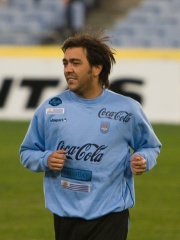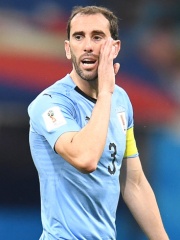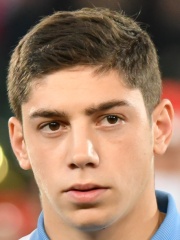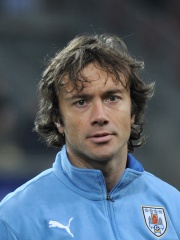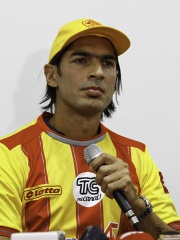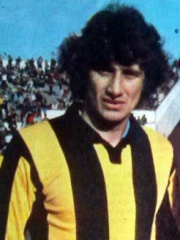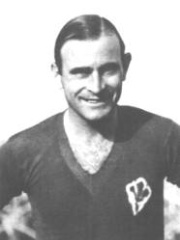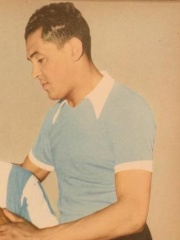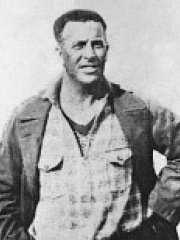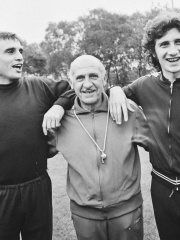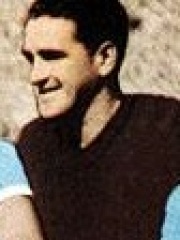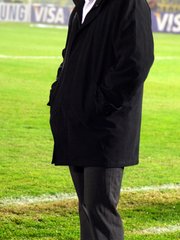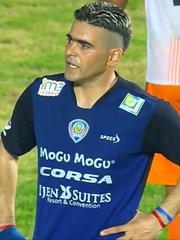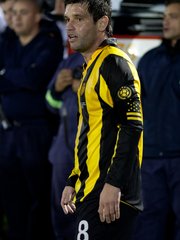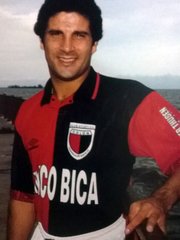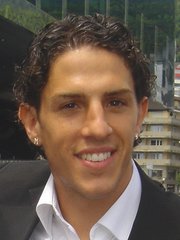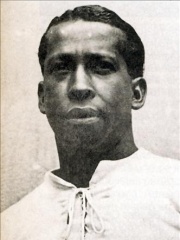
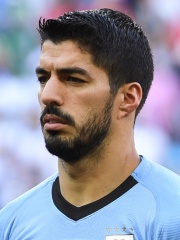
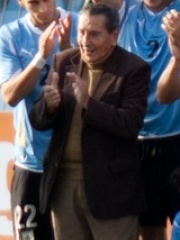
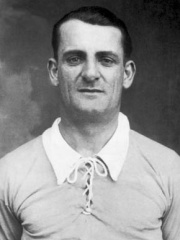
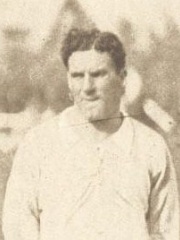
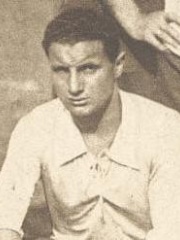
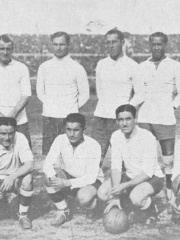
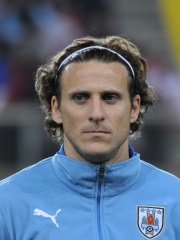
The Most Famous
SOCCER PLAYERS from Uruguay
This page contains a list of the greatest Uruguayan Soccer Players. The pantheon dataset contains 21,273 Soccer Players, 357 of which were born in Uruguay. This makes Uruguay the birth place of the 11th most number of Soccer Players behind Netherlands, and Sweden.
Top 10
The following people are considered by Pantheon to be the top 10 most legendary Uruguayan Soccer Players of all time. This list of famous Uruguayan Soccer Players is sorted by HPI (Historical Popularity Index), a metric that aggregates information on a biography's online popularity. Visit the rankings page to view the entire list of Uruguayan Soccer Players.

1. José Leandro Andrade (1901 - 1957)
With an HPI of 71.48, José Leandro Andrade is the most famous Uruguayan Soccer Player. His biography has been translated into 45 different languages on wikipedia.
José Leandro Andrade Quiroz (22 November 1901 – 5 October 1957) was a Uruguayan professional footballer who played as a wing-half. He was nicknamed "the Black Marvel" (maravilla negra). During his prime he was regarded as one of the finest players in the world, contributing to the Uruguay national team's domination of international football during the 1920s, winning two consecutive Olympic gold medals and then the inaugural FIFA World Cup.

2. Luis Suárez (b. 1987)
With an HPI of 70.83, Luis Suárez is the 2nd most famous Uruguayan Soccer Player. His biography has been translated into 104 different languages.
Luis Alberto Suárez Díaz (Spanish pronunciation: [ˈlwis ˈswaɾes]; born 24 January 1987) is a Uruguayan professional footballer who plays as a striker for Major League Soccer club Inter Miami. He is regarded as one of the best players of his generation and one of the greatest strikers of all time. Nicknamed "El Pistolero" ("the Gunman"), individually, he has won two European Golden Shoes, an Eredivisie Golden Boot, a Premier League Golden Boot and a Pichichi Trophy. He ranks fourth for the all-time South American men's top goalscorers in international football (69), only trailing Pelé (77), Neymar (79), and Lionel Messi (115). He has also scored over 600 career goals and provided over 300 assists for club and country. Suárez began his senior club career at Uruguayan club Nacional in 2005. He signed for Groningen the following year, before transferring to Ajax in 2007. There, he won the KNVB Cup and the Eredivisie. In 2011, Suárez signed for Premier League club Liverpool, and won the League Cup in his first full season. In his final season with the club, he produced one of the most dominant seasons in Premier League history; he equalled the goalscoring record for a 38-game Premier League season, with Liverpool finishing just two points behind Manchester City in the title race. That summer, Barcelona signed Suárez £64.98 million (€82.3 million adjusted for inflation), making him one of the most expensive players of all time. Suárez was part of a dominant attacking trio dubbed MSN, alongside Messi and Neymar. He won the treble of La Liga, the Copa del Rey and the UEFA Champions League in his first season, and in his second season he scored 59 goals in 53 matches as Barcelona won the double. He was named in the FIFA FIFPro World11 and awarded the Pichichi Trophy and his second European Golden Shoe, becoming the first player since 2009 to win both awards other than Messi or Cristiano Ronaldo. He was also the first player ever to simultaneously lead La Liga in goals and assists. In 2020, he signed for Atlético Madrid, where he was instrumental to the club's La Liga title triumph in his debut season. At international level, Suárez is Uruguay's all-time leading goalscorer, and formerly held the title of being the highest goalscorer in CONMEBOL FIFA World Cup qualifiers before being surpassed by Messi. He has represented his nation at four editions of the FIFA World Cup and five editions of the Copa América, as well as the 2012 Summer Olympics and the 2013 FIFA Confederations Cup. He was named in the 2010 World Cup All-Star Team and won the 2011 Copa América, where he was awarded Best Player. Outside of his football credentials, Suárez has been a source of controversy throughout his career, including a goal-line handball clearance against Ghana at the 2010 FIFA World Cup, biting opponents on three occasions, accusations of diving, racist incidents, and spitting incidents.

3. Alcides Ghiggia (1926 - 2015)
With an HPI of 70.14, Alcides Ghiggia is the 3rd most famous Uruguayan Soccer Player. His biography has been translated into 46 different languages.
Alcides Edgardo Ghiggia Pereyra (22 December 1926 – 16 July 2015) was a Uruguayan and Italian footballer who played as a right winger. He achieved lasting fame for his decisive role in the final match of the 1950 World Cup, and at the time of his death exactly 65 years later, he was also the last surviving player of Uruguay's 1950 World Cup squad.

4. José Nasazzi (1901 - 1968)
With an HPI of 70.06, José Nasazzi is the 4th most famous Uruguayan Soccer Player. His biography has been translated into 45 different languages.
José Nasazzi Yarza (24 March 1901 – 17 June 1968) was a Uruguayan footballer who played as a right-back or centre-back. He captained his country when they won the inaugural FIFA World Cup in 1930.
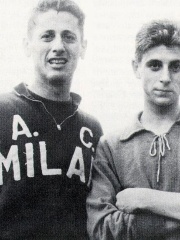
5. Juan Alberto Schiaffino (1925 - 2002)
With an HPI of 69.24, Juan Alberto Schiaffino is the 5th most famous Uruguayan Soccer Player. His biography has been translated into 44 different languages.
Juan Alberto "Pepe" Schiaffino Villalba (Italian pronunciation: [skjafˈfiːno]; 28 July 1925 – 13 November 2002) was a Uruguayan football player who played as an attacking midfielder or forward. A highly skilful and creative playmaker, at club level, he played for Peñarol in Uruguay, and for AC Milan, and Roma in Italy. At international level, he won the 1950 FIFA World Cup with the Uruguay national team, and also took part at the 1954 FIFA World Cup; he later also represented the Italy national football team. He was ranked as the best Uruguayan footballer of all time by an IFFHS poll, and the 17th greatest player of the twentieth century.

6. Héctor Scarone (1898 - 1967)
With an HPI of 69.23, Héctor Scarone is the 6th most famous Uruguayan Soccer Player. His biography has been translated into 42 different languages.
Héctor Pedro Scarone Berreta (26 November 1898 – 4 April 1967) was a Uruguayan footballer who played as inside forward. Known as "the Gardel of Football" and El Mago ("the Magician") due to his extraordinary skills with the ball, Scarone was considered one of the best players in the world during his time. He was crowned world champion three times, after winning the editions of the 1924 and 1928 Olympic football tournaments, along with the first World Cup in 1930. At club level, Scarone spent most of his career with Nacional, with which he won 21 official titles. He scored a total of 301 goals for the club in 369 appearances. Scarone holds the record of years played for Nacional, having spent 20 years with the club. He is also the 3rd. all-time Uruguayan Primera División with 163 goals, and the 2nd. all-time top scorer of Nacional (behind Atilio García) with 301 goals. With a height of 170 cm and thin legs, Scarone was rejected by Nacional at the age of 15. He returned one year later, being accepted by the club but sent to the reserve team. Nevertheless, Scarone would be promoted to the senior squad after playing only five matches in the reserve team. Apart from Nacional, Scarone also played for Spanish side Barcelona, and Italian clubs Inter Milan and Palermo. He was the younger brother of another legend of Nacional, Carlos Scarone.

7. Héctor Castro (1904 - 1960)
With an HPI of 67.71, Héctor Castro is the 7th most famous Uruguayan Soccer Player. His biography has been translated into 42 different languages.
Agustín Héctor Castro Rodríguez (29 November 1904 – 15 September 1960) was a Uruguayan football player and coach. He scored Uruguay's first ever goal in a World Cup against Peru at the inaugural FIFA World Cup in 1930 a tournament they would go on to win.

8. Enrique Ballestrero (1905 - 1969)
With an HPI of 67.45, Enrique Ballestrero is the 8th most famous Uruguayan Soccer Player. His biography has been translated into 38 different languages.
Enrique Pedro Ballestrero Griffo (18 January 1905 – 11 October 1969) was a Uruguayan footballer who played as a goalkeeper. He was a member of the Uruguay squad that won the 1930 FIFA World Cup. He played in all four matches of the tournament, including the final win against Argentina.

9. Diego Forlán (b. 1979)
With an HPI of 66.96, Diego Forlán is the 9th most famous Uruguayan Soccer Player. His biography has been translated into 82 different languages.
Diego Forlán Corazo (Spanish pronunciation: [ˈdje.ɣo foɾˈlan]; born 19 May 1979) is a Uruguayan football manager and a former player, who played as a forward, and last served as head coach for Uruguayan Segunda División club Club Atlético Atenas. Widely regarded as one of the best forwards of his generation, Forlán was praised for his versatility, intelligence, technique, and shooting abilities. As of 2024, Forlán is a professional tennis player, having made his ATP debut at the 2024 Uruguay Open. Forlán started his career in his native Uruguay as a youth player with Peñarol and Danubio, before joining Argentine club Independiente in 1997. After rising through their youth team and a successful four-year spell, he sealed a move to England with Manchester United in 2002. His form for Manchester United was not as successful as at Independiente, although he won the Premier League in 2002–03 and the FA Cup in 2003–04. In the summer of 2004, Forlán moved to Spanish side Villarreal. In his first season with the club, he won the Pichichi Trophy and European Golden Shoe with 25 goals. After two more successful seasons with Villarreal, during which he won the UEFA Intertoto Cup in 2004 and reached the semi-finals of the UEFA Champions League in 2005–06, Forlán joined Atlético Madrid in 2007 where, in the 2008–09 season, he once again became the league's top scorer, winning both the Pichichi Trophy and European Golden Shoe for the second time with 32 goals, becoming the first player to win the Pichichi Trophy twice since Ronaldo in 1996–97 and 2003–04. Forlán also won the UEFA Europa League, of which he scored the decisive goal in the final, and the UEFA Super Cup with Atlético Madrid, both in 2010. In 2011, he joined Italian club Inter Milan, before moving to Internacional in Brazil during the 2012 season. After spells in Japan with Cerezo Osaka, back in Uruguay with his boyhood club Peñarol, in India with Mumbai City and in Hong Kong with Kitchee, Forlán officially announced his retirement from professional football in August 2019. Forlán also had a successful international career, scoring 36 times for his country between his debut in 2002 and his international retirement in 2015. Forlán represented Uruguay in three FIFA World Cups (2002, 2010, 2014) and three Copa Américas (2004, 2007, 2011). His most notable achievement came at the 2010 FIFA World Cup, in which he led Uruguay to the final four for the first time since the 1970 FIFA World Cup, scoring five goals and one assist in the process, and was ultimately awarded the Golden Ball as the tournament's best player, selected for team of the tournament, and was the joint–top scorer. In the following year, Forlán earned his 79th international cap in a match against Mexico, breaking the record held since 1986 by goalkeeper Rodolfo Rodríguez, at the 2011 Copa América, in which Uruguay won for the first time since 1995, with Forlán scoring two goals in the final. On 20 June 2013, in a match against Nigeria at the 2013 Confederations Cup, Forlán became the first Uruguayan to win 100 caps. He was Uruguay's all-time leading top scorer from 2011 until Luis Suárez overtook him two years later in 2013. After retiring as a player, Forlán began his coaching career in Uruguay, managing Peñarol and Atenas in 2020 and 2021. He has also collaborated with FIFA in several ventures, having served as a tournament ambassador for the 2018 FIFA U-17 Women's World Cup, and since 2022, has served as an international ambassador for the FIFA Museum. Since July 2023, Forlán has continued his tennis career, competing in the ITF Masters tour, ranking in the 35+, 40+, and 45+ age categories, and played his first ATP event at the 2024 Uruguay Open in doubles with Federico Coria.
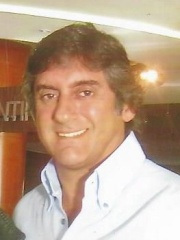
10. Enzo Francescoli (b. 1961)
With an HPI of 66.95, Enzo Francescoli is the 10th most famous Uruguayan Soccer Player. His biography has been translated into 46 different languages.
Enzo Francescoli Uriarte (Spanish pronunciation: [ˈenso fɾanseˈskoljuˈɾjaɾte]; born 12 November 1961), nicknamed "El Príncipe" (lit. 'The Prince'), is a Uruguayan former footballer who played as an attacking midfielder or forward. He is regarded as one of the best playmakers of his generation and as one of Uruguay's and South America's greatest ever players. He represented his nation at two FIFA World Cups, in 1986 and 1990, also winning the Copa América in 1983, 1987 and 1995. At club level, Francescoli began his career with Uruguayan club Wanderers. In neighbouring Argentina, he played for River Plate. He was the leading scorer and a key player for the club's second Copa Libertadores title. Francescoli won a total of five Argentine titles in the six years in which he played for the club. He also enjoyed success in France with Racing Paris and Marseille, where his performances proved decisive as the team won the 1989–90 French Division 1. He later also had spells in Italy with Cagliari and Torino, before returning to River Plate, where he ended his career. He was considered an elite playmaker in the Uruguay national team. He played 73 times for the Celeste between 1982 and his retirement in 1997, making him the most capped outfield player in Uruguayan international football at the time. Francescoli was the only Uruguayan included by Pelé in the FIFA 100 list of the world's greatest living footballers in 2004, and he was also elected by the International Federation of Football History & Statistics as the sixth-greatest Uruguayan player and the 24th greatest South American player of the 20th century.
People
Pantheon has 357 people classified as Uruguayan soccer players born between 1887 and 2003. Of these 357, 252 (70.59%) of them are still alive today. The most famous living Uruguayan soccer players include Luis Suárez, Diego Forlán, and Enzo Francescoli. The most famous deceased Uruguayan soccer players include José Leandro Andrade, Alcides Ghiggia, and José Nasazzi. As of April 2024, 41 new Uruguayan soccer players have been added to Pantheon including Diego Aguirre, Gianni Guigou, and Gabriel Correa.
Living Uruguayan Soccer Players
Go to all RankingsLuis Suárez
1987 - Present
HPI: 70.83
Diego Forlán
1979 - Present
HPI: 66.96
Enzo Francescoli
1961 - Present
HPI: 66.95
José Santamaría
1929 - Present
HPI: 65.35
Edinson Cavani
1987 - Present
HPI: 64.28
Álvaro Recoba
1976 - Present
HPI: 61.97
Pablo Forlán
1945 - Present
HPI: 61.44
Diego Godín
1986 - Present
HPI: 61.29
Federico Valverde
1998 - Present
HPI: 61.05
Diego Lugano
1980 - Present
HPI: 58.50
Sebastián Abreu
1976 - Present
HPI: 57.72
Fernando Morena
1952 - Present
HPI: 57.52
Deceased Uruguayan Soccer Players
Go to all RankingsJosé Leandro Andrade
1901 - 1957
HPI: 71.48
Alcides Ghiggia
1926 - 2015
HPI: 70.14
José Nasazzi
1901 - 1968
HPI: 70.06
Juan Alberto Schiaffino
1925 - 2002
HPI: 69.24
Héctor Scarone
1898 - 1967
HPI: 69.23
Héctor Castro
1904 - 1960
HPI: 67.71
Enrique Ballestrero
1905 - 1969
HPI: 67.45
Pedro Petrone
1905 - 1964
HPI: 66.86
Obdulio Varela
1917 - 1996
HPI: 66.70
Alberto Suppici
1898 - 1981
HPI: 65.16
Ladislao Mazurkiewicz
1945 - 2013
HPI: 65.03
Roque Máspoli
1917 - 2004
HPI: 64.83
Newly Added Uruguayan Soccer Players (2025)
Go to all RankingsDiego Aguirre
1965 - Present
HPI: 49.70
Gianni Guigou
1975 - Present
HPI: 46.69
Gabriel Correa
1968 - Present
HPI: 43.16
Cristian Gonzáles
1976 - Present
HPI: 42.77
Nelson Abeijón
1973 - Present
HPI: 42.69
Antonio Pacheco
1976 - Present
HPI: 42.32
Marcelo Saralegui
1971 - Present
HPI: 42.16
Franco Israel
2000 - Present
HPI: 42.13
Javier Delgado
1975 - Present
HPI: 40.96
Luis Barbat
1968 - Present
HPI: 40.66
Paulo Pezzolano
1983 - Present
HPI: 39.57
Carlos de Pena
1992 - Present
HPI: 38.50
Overlapping Lives
Which Soccer Players were alive at the same time? This visualization shows the lifespans of the 25 most globally memorable Soccer Players since 1700.

